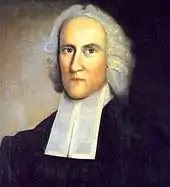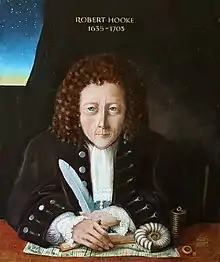1703
1703 (MDCCIII) was a common year starting on Monday of the Gregorian calendar and a common year starting on Friday of the Julian calendar, the 1703rd year of the Common Era (CE) and Anno Domini (AD) designations, the 703rd year of the 2nd millennium, the 3rd year of the 18th century, and the 4th year of the 1700s decade. As of the start of 1703, the Gregorian calendar was 11 days ahead of the Julian calendar, which remained in localized use until 1923.
| Millennium: | 2nd millennium |
|---|---|
| Centuries: | |
| Decades: | |
| Years: |
| 1703 by topic |
|---|
| Arts and science |
|
| Countries |
|
| Lists of leaders |
|
| Birth and death categories |
|
| Establishments and disestablishments categories |
|
| Works category |
|
| Gregorian calendar | 1703 MDCCIII |
| Ab urbe condita | 2456 |
| Armenian calendar | 1152 ԹՎ ՌՃԾԲ |
| Assyrian calendar | 6453 |
| Balinese saka calendar | 1624–1625 |
| Bengali calendar | 1110 |
| Berber calendar | 2653 |
| English Regnal year | 1 Ann. 1 – 2 Ann. 1 |
| Buddhist calendar | 2247 |
| Burmese calendar | 1065 |
| Byzantine calendar | 7211–7212 |
| Chinese calendar | 壬午年 (Water Horse) 4399 or 4339 — to — 癸未年 (Water Goat) 4400 or 4340 |
| Coptic calendar | 1419–1420 |
| Discordian calendar | 2869 |
| Ethiopian calendar | 1695–1696 |
| Hebrew calendar | 5463–5464 |
| Hindu calendars | |
| - Vikram Samvat | 1759–1760 |
| - Shaka Samvat | 1624–1625 |
| - Kali Yuga | 4803–4804 |
| Holocene calendar | 11703 |
| Igbo calendar | 703–704 |
| Iranian calendar | 1081–1082 |
| Islamic calendar | 1114–1115 |
| Japanese calendar | Genroku 16 (元禄16年) |
| Javanese calendar | 1626–1627 |
| Julian calendar | Gregorian minus 11 days |
| Korean calendar | 4036 |
| Minguo calendar | 209 before ROC 民前209年 |
| Nanakshahi calendar | 235 |
| Thai solar calendar | 2245–2246 |
| Tibetan calendar | 阳水马年 (male Water-Horse) 1829 or 1448 or 676 — to — 阴水羊年 (female Water-Goat) 1830 or 1449 or 677 |
Wikimedia Commons has media related to 1703.
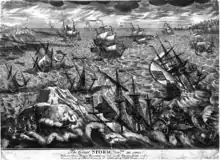
November 24: The Great Storm of 1703.
In the Swedish calendar it was a common year starting on Thursday, one day ahead of the Julian and ten days behind the Gregorian calendar.
Events
January–March
- January 9 – The Jamaican town of Port Royal, a center of trade in the Western Hemisphere and, at the time, the largest city in the Caribbean, is destroyed by a fire. British ships in the harbor are able to rescue much of the merchandise that has been unloaded on the docks, but the inventory in marketplaces in town is destroyed.[1]
- January 14 – The magnitude 6.7 Norcia earthquake affects Central Italy with a maximum Mercalli intensity of XI (Extreme). With a death toll of 6,240–9,761, it is the first in a sequence of three destructive events.
- January 16 – The magnitude 6.2 Montereale earthquake causes damage at Accumoli, Armatrice, Cittareale, and Montereale, with a maximum Mercalli intensity of VIII (Severe).
- January 30 (December 14 of previous year in the Chinese calendar) – In Japan, Forty-seven rōnin assassinate daimyō Kira Yoshinaka, the enemy of their former lord Asano Naganori, at his own mansion as a vengeance; 46 of the 47 samurai commit seppuku, a ritual suicide on March 20 (February 4 in the Chinese calendar).
- February 2 – The magnitude 6.7 L'Aquila earthquake affects Central Italy, with a maximum Mercalli intensity of X (Extreme). In the final large event (an example of Coulomb stress transfer), damage occurs as far distant as Rome, with landslides, liquefaction, slope failures and at least 2,500 deaths.
- February – Soldiers at Fort Louis de la Mobile celebrate Mardi Gras in Mobile, starting the tradition for Mobile, Alabama.
- March 1 – The Recruiting Act 1703 goes into effect in England, providing for the forcible enlistment of able-bodied, but unemployed, into the English Army and Royal Navy in order to fight in Queen Anne's War in North America. The Act expires at the end of February, 1704.
- March 15 – The landmark English court case of Rose v Royal College of Physicians is decided by the Court of Queen's Bench, beginning the end of the monopoly that the Royal College of Physicians has over the practice of medicine.
- March 19 – The Siege of Guadeloupe begins as an expeditionary force, led by Christopher Codrington and Hovenden Walker, lands at Basse-Terre and attempts to take over the French-held island. The English fleet departs on May 15 after being unable to capture Guadeloupe.[2]
- March 20 – The Akō incident occurs in Japan as 46 independent samurai (rōnin) carry out an order of seppuku (ritual suicide) for the revenge murder of a high-ranking government official, Kira Yoshinaka, on January 30. The punishment is given by the shōgun, Tokugawa Tsunayoshi. The story continues to be dramatized more than 300 years later in novels, film and theater.
- March 21 – Jeanne Guyon is freed in Paris after more than seven years imprisonment for heresy in the Bastille.
April–June
- April 21 – The Company of Quenching of Fire (i.e., a fire brigade) is founded in Edinburgh, Scotland.
- May 26 – Portugal joins the Grand Alliance.
- May 27 (May 16 OS) – The city of Saint Petersburg, Russia is founded, following Peter the Great's reconquest of Ingria from Sweden, during the Great Northern War.
- June 15 – Hungarians rebel under Prince Francis II Rákóczi.
- June 19 – Bavarian troops, who during the so-called Bavarian Rummel had invaded Tyrol, besiege Kufstein. Fires break out on the outskirts that engulf the town, destroy it and reach the powder store of the supposedly impregnable fortress. The enormous gunpowder supplies explode and Kufstein has to surrender on 20 June. That same day the Tyrolese surrender in Wörgl; two days later Rattenberg is captured and Innsbruck is cleared without a fight on 25 June.
- June – The completed Icelandic census of 1703 is presented in the Althing, the first complete census of any country.
July–September
- July 26 – After their victories at the Pontlatzer Bridge and the Brenner Pass, Tyrolese farmers drive out the Bavarian Elector, Maximilian II Emanuel, from North Tyrol and thus prevent the Bavarian Army, which is allied with France, from marching on Vienna during the War of the Spanish Succession. This success, at low cost, is the signal for the rebellion of the Tyrolese against Bavaria, and Elector Maximilian II Emanuel has to flee from Innsbruck. The Bavarian Army withdraws through Seefeld in Tirol back to Bavaria.
- July 29–31 – Daniel Defoe is placed in a pillory, then imprisoned for four months for the crime of seditious libel after publishing his satirical political pamphlet The Shortest Way with the Dissenters (1702) (his release is granted in mid-November).
- August 23 – Edirne event: Sultan Mustafa II of the Ottoman Empire is dethroned.
- September 7 – War of the Spanish Succession: The town of Breisach is retaken for France by Camille d'Hostun, duc de Tallard.
- September 12 – War of the Spanish Succession: Habsburg Archduke Charles is proclaimed King of Spain, but never exercises full rule.
October–December
- October 11 – Nine Roman Catholic residents of the French village of Sainte-Cécile-d'Andorge are massacred by a mob of more than 800 French Huguenot Protestants, the Camisards. A reprisal against Protestants in the nearby village of Branoux is made less than three weeks later.
- October 23 – Hannah Twynnoy, a 24-year-old barmaid in Malmesbury, Wiltshire, becomes the first person to be killed in Great Britain by a tiger. While working at the White Lion Inn, where a group of wild animals is on exhibit, she is mauled after bothering the tiger.
- October 30 – More than 47 Huguenots in the village of Branoux-les-Taillades are massacred by Roman Catholic vigilantes in reprisal for the October 11 attack on nearby Sainte-Cécile, slightly more than two miles away.
- November 15
- War of the Spanish Succession: Battle of Speyerbach (in modern-day Germany) – The French defeat a German relief army, allowing the French to take the besieged town of Landau two days later, for which Tallard is made a Marshal of France.
- Rákóczi's War of Independence: Battle of Zvolen (in modern-day Slovakia) – The Kurucs defeat the Austrians and their allies (Denmark, Hungary and the Serbs).
- November 19 – The Man in the Iron Mask dies in the Bastille, in France.
- November 30 – Isaac Newton is elected president of the Royal Society in London, a position he will hold until his death in 1727.
- December 7–10 (November 26–29 O.S.) – The Great Storm of 1703, an Atlantic hurricane, ravages southern England and the English Channel, killing at least 8,000, mostly at sea. The Eddystone Lighthouse off Plymouth is destroyed in the storm together with its designer Henry Winstanley.[3]
- December 27 – Portugal and England sign the Methuen Treaty, which gives preference to Portuguese wines imported into England.
- December 28 – Ahmed III succeeds the deposed Mustafa II as Ottoman Emperor.
Date unknown
- French-born imposter George Psalmanazar arrives in London.
- Between 1702 and 1703, an epidemic of smallpox breaks out in Quebec, in which 2,000-3,000 people die (300-400 in Quebec City).[4]
Births
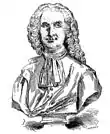
Daniel-Charles Trudaine born 3 January
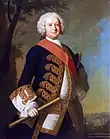
Peter Warren (Royal Navy officer) born 10 March
%252C_by_George_Romney%252C_1781.jpg.webp)
Edmund Law born 6 June

John Wesley born 28 June
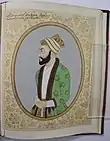
Muhammad Ibrahim (Mughal emperor) born 9 August
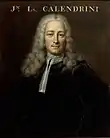
Jean-Louis Calandrini born 30 August
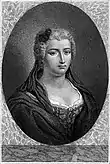
Louise Levesque born 23 November
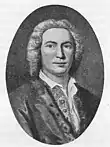
Simon Carl Stanley born 12 December
January–March
- January 1 – Heinrich Sigismund von der Heyde, Prussian army commander (d. 1765)
- January 2 – George Cholmondeley, 3rd Earl of Cholmondeley, English politician (d. 1770)
- January 3 – Daniel-Charles Trudaine, French administrator and civil engineer (d. 1769)
- January 5
- January 8 – André Levret, French obstetrician who practised medicine in Paris (d. 1780)
- January 10 – Christoph Birkmann, German theologian and minister (d. 1771)
- January 15
- January 20 – Joseph-Hector Fiocco, Belgian composer and violinist (d. 1741)
- January 22 – Antoine Walsh, Irish-French slave trader and Jacobite (d. 1763)
- January 29 – Carlmann Kolb, German priest (d. 1765)
- January 31 – André-Joseph Panckoucke, French author and bookseller (d. 1753)
- February 2 – Richard Morris, Welsh writer and editor (d. 1779)
- February 3 – Jean Philippe de Bela, French military figure and Basque writer and historian (d. 1796)
- February 4
- February 5 – Gilbert Tennent, Irish-born religious leader (d. 1764)
- February 8
- February 13 – Robert Dodsley, English bookseller, poet, playwright and miscellaneous writer (d. 1764)
- February 27 – Lord Sidney Beauclerk, English politician and fortune hunter (d. 1744)
- March 1 – Philip Tisdall, Attorney-General for Ireland (d. 1777)
- March 4 – Nicolas René Berryer, French magistrate and politician (d. 1762)
- March 5 (N. S.) – Vasily Trediakovsky, Russian poet (d. 1768)
- March 10 – Peter Warren, British Royal Navy officer (d. 1752)
- March 21 – Georg Andreas Sorge, Thuringian organist (d. 1778)
- March 23 – Cajsa Warg, Swedish cookbook author (d. 1769)[6]
April–June
- April 8 – Benoît-Joseph Boussu, French violin maker (d. 1773)
- April 10 – Pierre Daubenton, French lawyer (d. 1776)
- April 24 – José Francisco de Isla, Spanish Jesuit (d. 1781)
- May 2 – James West, English antiquary (d. 1772)
- May 8 – Johann Gottlob Harrer, German composer and choir leader (d. 1755)
- May 10 – John Winslow, British Army officer (d. 1774)
- May 12 – Countess Sophie Theodora of Castell-Remlingen, German noblewoman (d. 1777)
- May 14 – David Brearly, delegate to the U.S. Constitutional Convention (d. 1785)
- May 18
- May 20 – René Lièvre de Besançon, French archer (d. 1739)
- June 6 – Edmund Law, priest in the Church of England (d. 1787)
- June 10 – Walter Butler, 16th Earl of Ormonde, Irish landowner (d. 1783)
- June 21 – Joseph Lieutaud, French physician (d. 1780)
- June 24 – Anne van Keppel, Countess of Albemarle (d. 1789)
- June 26 – Thomas Clap, first president of Yale University (d. 1767)
- June 28 – John Wesley, English founder of Methodism and anti-slavery activist (d. 1791)[7]
July–September
- July 7 – Kenrick Prescot, English Anglican priest and academic (d. 1779)
- July 9 – Edward Shippen III, American merchant and mayor of Philadelphia (d. 1781)
- July 12 – Nicholas Hewetson, Anglican priest in Ireland (d. 1761)
- July 17 – Thomas Hancock, merchant in colonial Boston (d. 1764)
- August 2 – Lorenzo Ricci, Italian Jesuit leader (d. 1775)
- August 4 – Louis, Duke of Orléans, member of the royal family of France (d. 1752)
- August 9 – Muhammad Ibrahim, claimant to the throne of India (d. 1746)
- August 15 – Jacob Bicker Raije, writer from the Northern Netherlands (d. 1777)
- August 24 – François-Marie Le Marchand de Lignery, colonial military leader in the French province of Canada (d. 1759)
- August 30 – Jean-Louis Calandrini, Genevan scientist (d. 1758)
- September 1 – Just Fabritius, Danish merchant (d. 1766)
- September 3 – Johann Theodor of Bavaria, cardinal (d. 1763)
- September 6 – John Harris, British landowner and politician (d. 1768)
- September 15 – Guillaume-François Rouelle, French chemist (d. 1770)
- September 23 – Charlotte Howe, Viscountess Howe, Hanover-born British courtier and politician (d. 1782)
- September 29
October–December
- October 3 – Franz Christoph Janneck, Austrian painter in the Baroque style (d. 1761)
- October 5 – Jonathan Edwards, North American revivalist preacher (d. 1758)
- October 6 – Louis de Beaufort, French-Dutch historian known for his critical approach to the history of Rome (d. 1795)
- October 7 – Frederick, Hereditary Prince of Baden-Durlach, German hereditary prince (d. 1732)
- October 13
- October 15 – Benigna Gottliebe von Trotta genannt Treyden, Duchess consort of Courland (d. 1782)
- October 16
- October 22 – Edward Rudge, English politician (d. 1763)
- October 23 – Sir Alexander Dick, 3rd Baronet, Scottish landowner and physician (d. 1785)
- October 28
- October 30 – James Hill, Scottish surgeon who advocated curative excision for cancer (d. 1776)
- November 1 – Frederik Danneskiold-Samsøe, Danish politician (d. 1770)[9]
- November 10 – Carlo Zuccari, Italian composer and violinist (d. 1792)
- November 17 – Adam Miller, German-born pioneer in the colony of Virginia (d. 1783)
- November 18 – Andrew Rollo, 5th Lord Rollo, Scottish army commander in Canada and Dominica during the Seven Years' War (d. 1765)
- November 22
- November 23 – Louise Levesque, French femme de lettres (d. 1743)
- November 25 – Jean-François Séguier, French astronomer and botanist (d. 1784)
- November 26 – Theophilus Cibber, English actor and writer (d. 1758)
- November 27 – James De Lancey, colonial governor of the Province of New York (d. 1760)
- December 2 – Ferdinand Konščak, Croatian Jesuit missionary, explorer and cartographer (d. 1759)
- December 9 – Chester Moore Hall, British lawyer and inventor who produced the first achromatic lenses (d. 1771)
- December 12 – Simon Carl Stanley, Danish sculptor of English parentage (d. 1761)
- December 15
- December 23 – Stephen Cornwallis, career British Army officer and politician (d. 1743)
- December 24
- unknown date – Johann Gottlieb Graun, German Baroque/Classical era composer and violinist (d. 1771)
Deaths
- January 9 – Úrsula Micaela Morata, Spanish writer (b. 1628)
- January 11 – Johann Georg Graevius, German classical scholar and critic (b. 1632)[10]
- January 16 – Erik Dahlbergh, Swedish engineer, soldier and field marshal (b. 1625)
- February 15 – Robert Kerr, 1st Marquess of Lothian (b. 1636)
- February 18
- February 20 – John Churchill, Marquess of Blandford, British noble (b. 1686)
- February 28 – Sir Roger Twisden, 2nd Baronet of England (b. 1640)
- March 3 – Robert Hooke, English scientist (b. 1635)[11]
- March 12 – Aubrey de Vere, 20th Earl of Oxford (b. 1627)
- March 31 – Johann Christoph Bach, German composer (b. 1642)[12]
- April 1 – Thomas Jermyn, 2nd Baron Jermyn, Governor of Jersey (b. 1633)
- April 20 – Lancelot Addison, English royal chaplain (b. 1632)[13]
- May 3 – Sir Richard Grobham Howe, 2nd Baronet, English Member of Parliament (b. 1621)
- May 6 – John Murray, 1st Marquess of Atholl (b. 1631)
- May 16 – Charles Perrault, French author (b. 1628)[14]
- May 26
- Louis-Hector de Callière, French politician (b. 1648)
- Samuel Pepys, English civil servant and diarist (b. 1633)[15]
- June 14 – Jean Herauld Gourville, French adventurer (b. 1625)
- June 19 – William Stanhope, English politician (b. 1626)
- July 17 – Roemer Vlacq I, Dutch naval captain (b. 1637)
- July 20
- August 10 – Fuquan (prince), Chinese Qing Dynasty prince (b. 1653)
- August 21 – Thomas Tryon, British hat maker (b. 1634)
- September 22 – Vincenzo Viviani, Italian mathematician and scientist (b. 1622)
- September 25 – Archibald Campbell, 1st Duke of Argyll, Scottish privy councillor (b. 1658)
- September 29 – Charles de Saint-Évremond, French soldier (b. 1610)
- September 30 – Walter J. Johnson, English explorer, fur trader (b. 1611)
- October 3 – Alessandro Melani, Italian composer (b. 1639)
- October 8 – Tomás Marín de Poveda, 1st Marquis of Cañada Hermosa, Royal Governor of Chile (b. 1650)
- October 11 – Roger Cave, English politician (b. 1655)
- October 14 – Thomas Kingo, Danish bishop (b. 1634)
- October 28 – John Wallis, English mathematician (b. 1616)
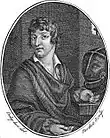
Man in the Iron Mask
- November 19 – The Man in the Iron Mask (identity unknown)
- November 27 – Henry Winstanley, English engineer (b. 1644)
- November 30 – Nicolas de Grigny, French organist and composer (b. 1672)[16]
- December 28 – Mustafa II, Ottoman Sultan (b. 1664)
- date unknown
References
- "Fires, Great", in The Insurance Cyclopeadia: Being an Historical Treasury of Events and Circumstances Connected with the Origin and Progress of Insurance, Cornelius Walford, ed. (C. and E. Layton, 1876) p47
- "High Tide of Empire (1700-1777)", in Wars of the Americas: A Chronology of Armed Conflict in the New World, 1492 to the Present, by David Marley (ABC-CLIO, 1998) p.225
- "Icons, a portrait of England 1700-1750". Archived from the original on August 17, 2007. Retrieved July 28, 2018.
- Lessard, Rénald (1995). "L'Épidémie de variole de 1702-1703". Cap-aux-Diamants: La revue d'histoire du Québec (in French). 42: 51.
- Bulletin. City Art Museum of St. Louis. 1996. p. 31.
- Wine and Food. Wine and Food Society. 1962. p. 165.
- John Wesley (1833). Life of the Rev. John Wesley. R. T. S. p. 125.
- William John Arthur Charles James Cavendish-Bentinck Duke of Portland; Charles Fairfax Murray (1894). Catalogue of the Pictures Belonging to His Grace the Duke of Portland: At Welbeck Abbey, and in London. 1894. Pr. at the Chiswick Press. p. 165.
- "Danneskiold-Samsøe, Frederik" (in Danish). Danish Biographical Encyclopedia. Archived from the original on October 11, 2016. Retrieved September 16, 2016.
- William Nicolson (1985). The London Diaries of William Nicolson, Bishop of Carlisle 1702-1718. OUP Oxford. p. 198. ISBN 978-0-19-822404-4.
- Richard Nichols (1999). Robert Hooke and the Royal Society. Book Guild. p. 50. ISBN 978-1-85776-465-9.
- Boston Symphony Orchestra (1894). Programme. The Orchestra. p. 403.
- Joseph Addison (1877). The Works of the Right Honourable Joseph Addison. George Bell & Son. p. 345.
- Charles Perrault; Neil Philip (1993). The Complete Fairy Tales of Charles Perrault. Houghton Mifflin Harcourt. p. 125. ISBN 0-395-57002-6.
- Samuel Pepys (1926). Private Correspondence and Miscellaneous Papers of Samuel Pepys, 1679-1703: In the Possession of J. Pepys Cockerell. G. Bell and sons, Limited. p. 137.
- Paul E. Eisler (1972). World Chronology of Music History: 1594-1684. Oceana Publications. p. 432. ISBN 978-0-379-16082-6.
This article is issued from Wikipedia. The text is licensed under Creative Commons - Attribution - Sharealike. Additional terms may apply for the media files.
